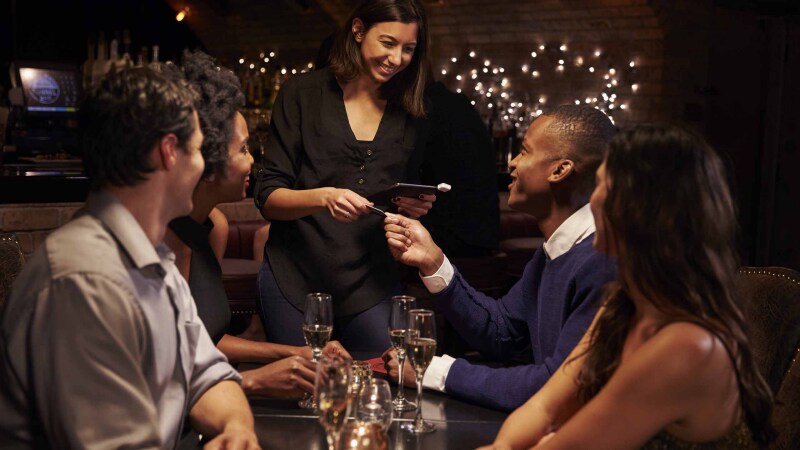How much should you tip?

Tipping is a way some people might show appreciation for a good meal or for services received. In some cultures, it’s common to tip for a nice meal at a restaurant. But what about other situations? Should you tip for a buffet? Should you tip the same for a cup of cold brew as you do for a bellboy carrying seven bags to your room? What about tipping during the holidays?
Whether you’re in a new situation or new to tipping as a practice, you might find yourself wondering what makes for an appropriate tip. The good news is that there are some potentially useful guidelines for tipping for various services. Let’s try to take the guesswork out of it with a few tips on tipping.
What is a good tip?
Depending on where you live, tipping might be a nearly everyday part of life. Whether you’re dining out, taking a taxi or getting a haircut, there are quite a few situations where people tip regularly. But how much should you tip? Nowadays, many places lean toward 15-20% of the bill for services where tipping is customary, such as dining out. But a truly definitive, one-size-fits-all answer might be pretty hard to find. How much you should tip depends on many factors, such as:
- Type of service: Some services demand more from their provider in terms of skill, time or effort. You might consider tipping a bit more when there’s increased personalization and attention.
- Quality of service: A tip is often seen as a reflection of your appreciation. Exceptional service might merit a higher tip. For example, if someone goes out of their way to make your experience more memorable, it might be worth considering a tip above the standard rate.
- Bill size: Typically, people tip as a percentage of the total bill. This percentage might vary in size depending on the two factors above, namely the quality and type of service. But there are some instances where a flat rate might be more appropriate. For example, when ordering individual drinks at a bar, a common practice is to tip a flat dollar per drink rather than calculating a percentage.
Tipping etiquette by situation
While there are general guidelines for tipping, tipping amounts remain largely situational. Knowing the standards around tipping might help prevent any awkward exchanges and make the practice more intentional and reflective of the services you receive. With that in mind, here are a few general tipping guidelines you could fall back on:
Tipping at restaurants
How much should you tip at a restaurant? A typical tip at a restaurant might range between 15-20% of the pre-tax total, depending on where you are and your satisfaction with the service. For buffet-style settings, 10% is often considered adequate since you’re doing some of the legwork yourself. If you’re part of a large party, don’t be surprised if a service charge is automatically added to your bill — many restaurants add service charges to ensure the serving staff are compensated for handling bigger groups.
Tipping for personal care services
When it comes to personal care services like haircuts, massages or manicures, tipping etiquette is pretty consistent. Some might find that a 15-20% tip reflects their level of satisfaction. If you see multiple providers during your visit, such as a colorist and stylist in a salon, it’s common practice to tip each one separately based on the service they provided.
Tipping for transport
Transport is another area commonly associated with tipping. Here, the general 15-20% serves many well, though some people might opt for a flat dollar amount based on the length or complexity of the ride.
Tipping at hotels
The world of hotels comes with its own set of tipping etiquette. It’s customary to tip bellmen according to the number of bags they assist with, such as two dollars for the first bag and one dollar for every one after. A concierge might merit a tip for executing special services like booking a hard-to-get reservation. Housekeeping will likely appreciate a tip as well.
Tipping during holidays
The holiday season raises questions about how much you should tip for various services, particularly those you use regularly. Tipping etiquette here suggests leaning toward showing extra appreciation. You might consider, for example, tipping a little more than you would for your regular hair stylist or any servers you see regularly at your favorite restaurant.
People who provide regular services without any direct financial transactions between you, such as doormen for your building, may also merit tips during the holiday season. In these cases, the same general tipping guidelines apply: Your tips (generally a flat dollar amount) are reflective of your level of appreciation for the quality of service you’ve received.
When not to tip
Not every service or situation calls for a tip. There are some instances where it’s unnecessary or potentially even seen as inappropriate. Understanding tipping etiquette extends to knowing when not to tip as well. Here are some instances where you might want to keep your wallet in your pocket:
Cultural context
Tipping customs are different everywhere and can differ dramatically from one country to another. In some places, like Japan,cia-world-factbook-japan tipping may even be considered rude. In other places, service charges are automatically included in your bill, making additional tips potentially unnecessary. Considering the cultural norms of the location you’re in can help provide guidance on how to tip.
Health and wellness settings
In many healthcare settings, tipping is generally not expected. For example, you’d be unlikely to tip a nurse after a routine check-up or a dental hygienist after a cleaning. In these scenarios, the “service” provided is considered part of the overall healthcare experience rather than a separate entity meriting its own compensation.
Salaried professionals
Another area where tipping isn’t customary involves salaried professionals like lawyers, accountants or consultants. These individuals typically do not expect, nor do they typically receive, tips for their services. The fees for their professional expertise are understood to be fully compensatory.
Government and public services
While some might think about tipping their mail carrier or the garbage collectors that help keep their neighborhood clean, especially around the holidays, many places prohibit government employees from accepting tips. For such situations, a small gift or token of appreciation might be permitted in lieu of a tip and could be a nice gesture. Check with your local regulations for further clarification regarding tips and gifts.
Remember that tips should be made in consideration of your overall budget. Tipping should, ideally, be an enjoyable experience for both parties.
In summary
How much should you tip? While there are a few general guidelines to fall back on, such as 15-20% of the bill, there are a few factors to consider. A tip is thought to be reflective of the quality of service you’ve received. Tipping etiquette also suggests that the more personalized and more extensive the effort involved with the service, the higher the tip might be. Just remember to additionally consider the cultural context you’re in and the service or industry you’re tipping for.



